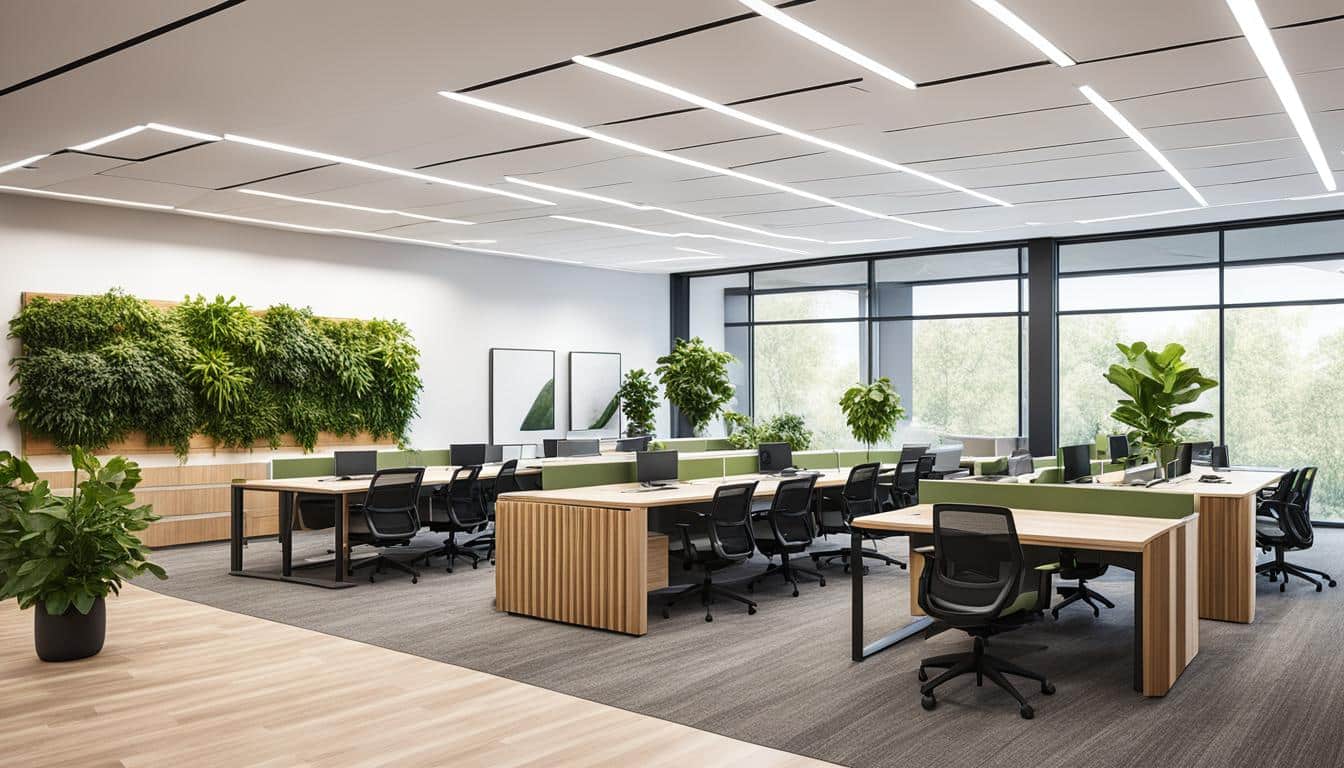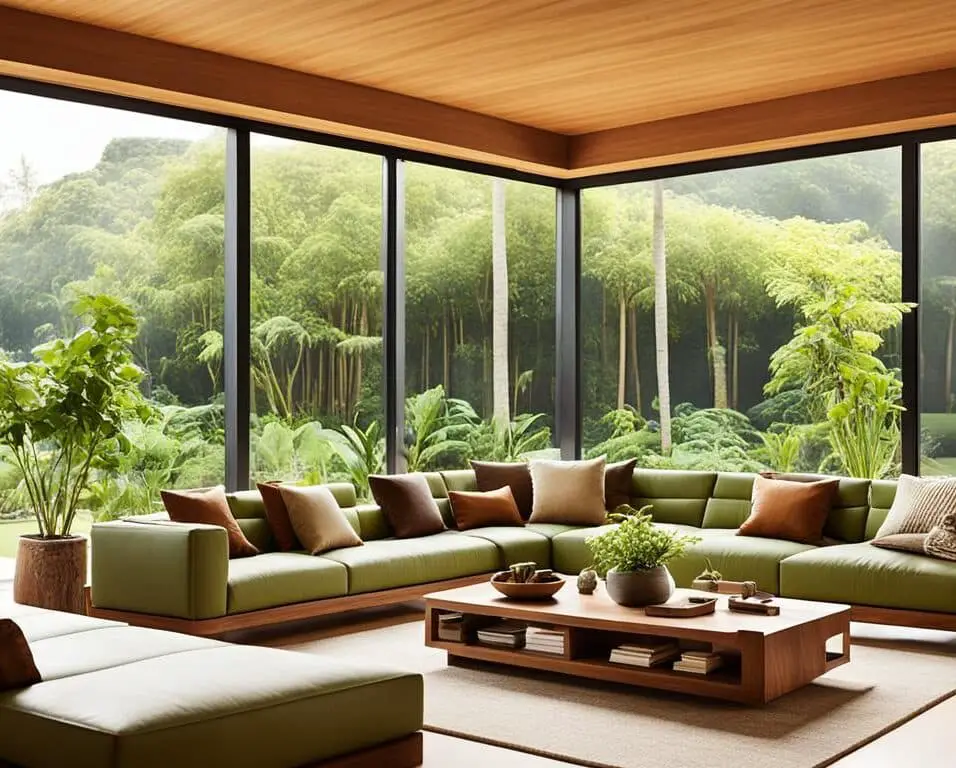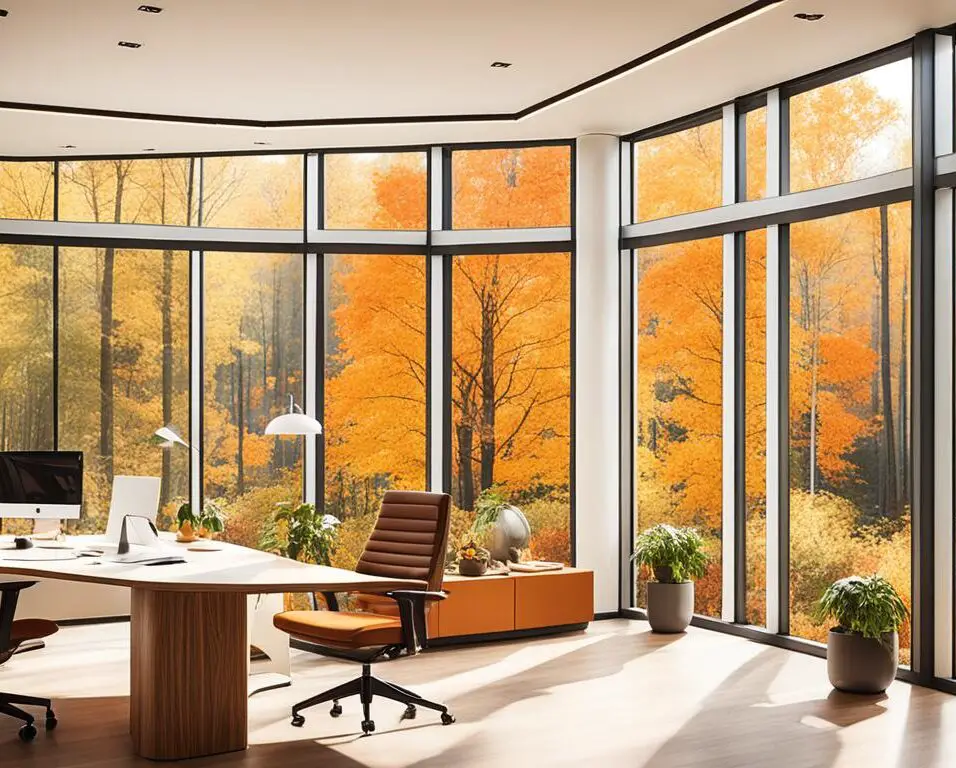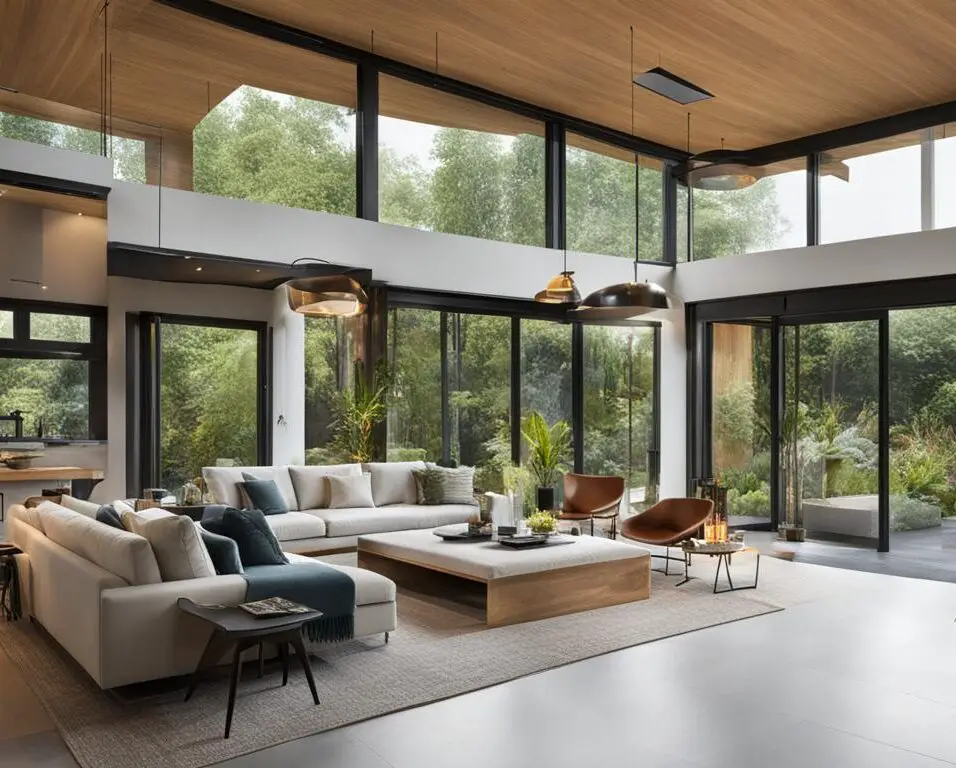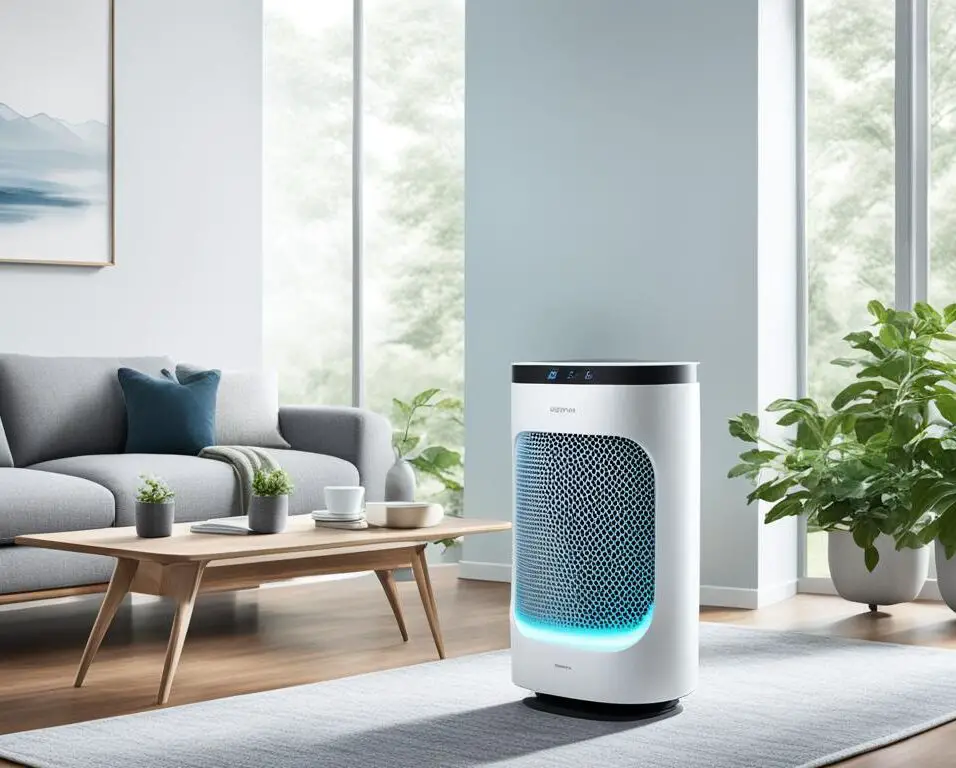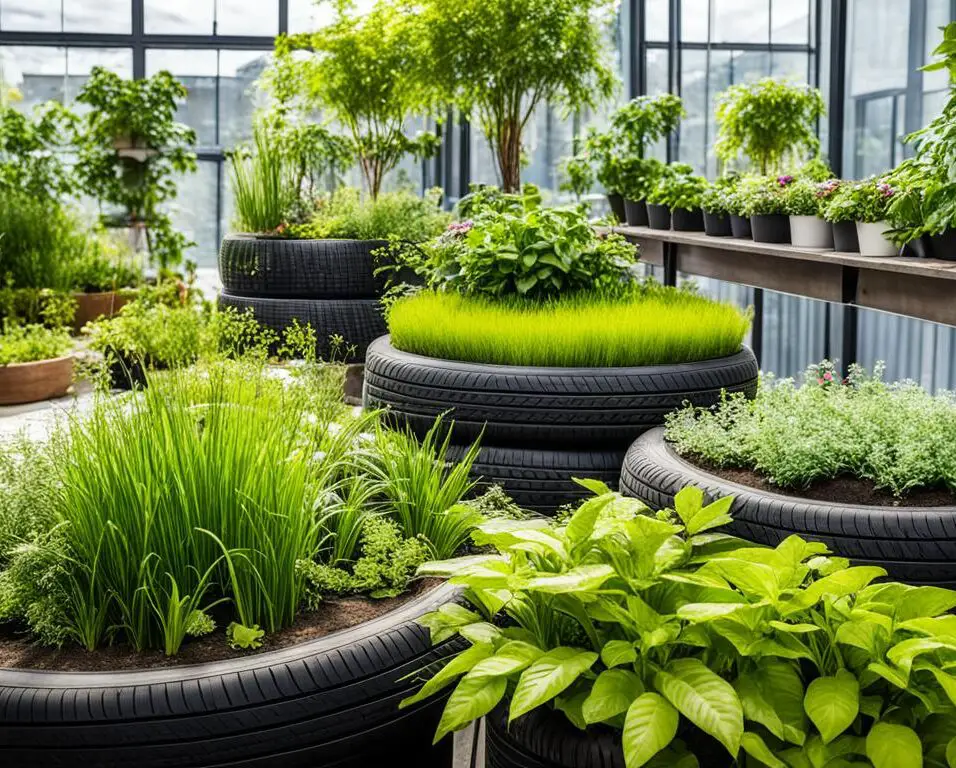Harmony in Silence: Acoustic Design Elements in Biophilic Architecture
Welcome to the captivating world of biophilic architecture, where nature and design converge to create serene spaces that enhance well-being. In this article, I will delve into the pivotal role that acoustic design elements play in biophilic architecture, transcending mere aesthetics to provide a harmonious living environment. From reducing stress to improving air quality, these elements foster a profound connection with nature that nurtures the mind, body, and soul.
Key Takeaways:
- Acoustic design elements in biophilic architecture create serene spaces that enhance well-being.
- These elements go beyond aesthetics, reducing stress, improving air quality, and promoting concentration and creativity.
- Biophilic architecture fosters a harmonious connection with nature, creating a nurturing living environment.
- By integrating acoustic design elements, we can create spaces that promote relaxation and enhance overall well-being.
- Biophilic architecture contributes to the creation of serene and nature-inspired spaces that enhance well-being.
The Importance of Indoor Plants in Biophilic Design
Indoor plants play a vital role in biophilic design, creating a seamless connection between nature and indoor spaces. Not only do they bring visual appeal, but indoor plants also offer a multitude of benefits for our well-being.
“Indoor plants create a sense of calm and serenity, contributing to a healthier and more harmonious environment.” – Biophilic Design Specialist
Aesthetic Enhancement and Visual Appeal
Indoor plants have the power to transform any space with their natural beauty. They add a touch of greenery, texture, and vibrancy to the surroundings, creating visually captivating areas. Whether it’s a lush fern cascading down a hanging pot or a towering fiddle-leaf fig, indoor plants bring life and freshness to any room.
Air Purification and Improved Indoor Air Quality
One of the remarkable benefits of indoor plants is their ability to act as natural air purifiers. Through a process called photosynthesis, plants absorb carbon dioxide and release oxygen, improving the quality of the air we breathe. Additionally, indoor plants can eliminate indoor pollutants such as benzene and formaldehyde, which are commonly found in household items like furniture and cleaning products.
Mental Well-being and Stress Reduction
Indoor plants have a profound impact on our mental well-being. Studies have shown that the presence of plants can reduce stress levels, enhance concentration, and improve overall mood and productivity. The peaceful and calming effect of plants promotes relaxation and provides a sanctuary amidst our often hectic modern lifestyles.
Creativity and Productivity Boost
Biophilic environments that incorporate indoor plants have been found to promote creativity and boost productivity. Research suggests that being in the presence of plants can stimulate the brain and enhance cognitive function. Whether it’s a small desk plant or a large statement piece in a shared workspace, indoor plants can inspire fresh ideas and support innovation.
Choosing the Right Indoor Plants
When selecting indoor plants for biophilic design, it is essential to consider factors such as lighting conditions, space availability, and personal preferences. Low-maintenance options like snake plants and succulents are perfect for busy individuals or those with limited time for plant care. On the other hand, flowering plants such as orchids or peace lilies can add a burst of color and elegance to any room. Choosing the right indoor plants ensures they thrive in their designated spaces and continue to enhance the overall ambiance.
Integrating indoor plants into biophilic design creates a harmonious and rejuvenating environment. The visual appeal, air purification, mental well-being, and the overall positive impact of indoor plants make them indispensable elements in creating spaces that reconnect us with nature.
Designing a Veterinary Hospital with Acoustic Considerations
When it comes to designing a veterinary hospital, acoustic considerations play a crucial role in creating a comforting environment for both animals and humans. The design should focus on optimizing traffic flow for pets and pet owners, while also taking into account the efficient movement of staff and minimizing distractions. Implementing noise control measures is essential to create a quiet and calm atmosphere.
Traffic Flow
Optimizing traffic flow is key to ensuring a smooth experience for both pets and their owners. Strategic placement of entrances, exits, and waiting areas helps to minimize congestion and facilitate easy movement throughout the facility. By carefully planning the floorplan, veterinarians and staff can efficiently attend to the needs of animals and provide a seamless experience for pet owners.
Staff Workflow
The design of a veterinary hospital should also consider the workflow of the staff, allowing them to perform their duties efficiently and effectively. By creating distinct areas for consultations, examinations, and treatments, veterinary professionals can move seamlessly from one task to another. Careful consideration should also be given to the placement of essential equipment and supplies, ensuring that everything is within easy reach and minimizing unnecessary interruptions.
Noise Control
Noise control is essential in a veterinary hospital to create a calm and stress-free environment for both animals and humans. Soundproof walls, silent phone systems, and sound-absorbing materials can help minimize the impact of noise and create a soothing atmosphere. By implementing these measures, veterinary professionals can reduce anxiety in their animal patients and provide a more peaceful experience for both pets and their owners.
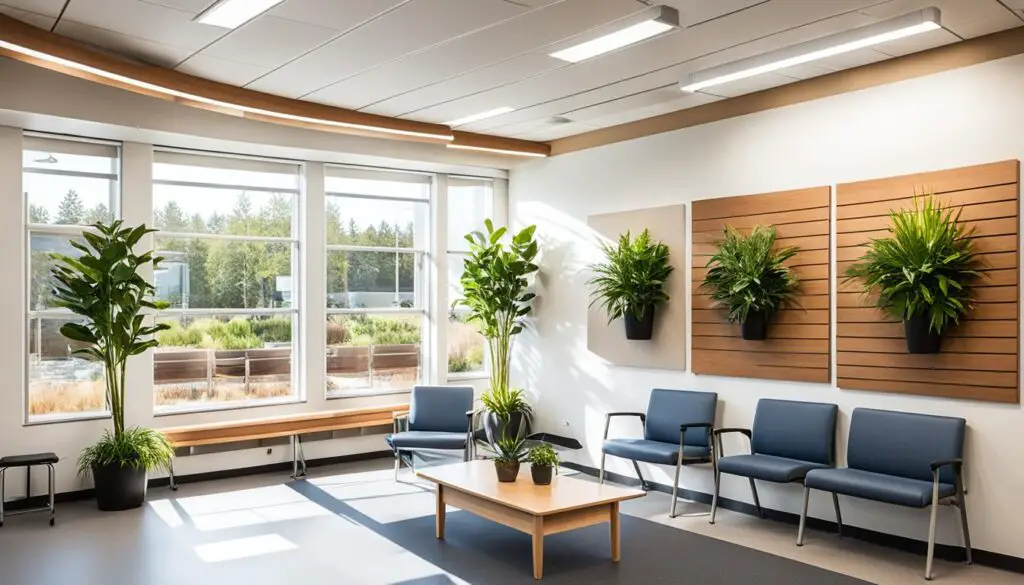
Designing a veterinary hospital with acoustic considerations is essential for creating a comfortable and peaceful environment for animals, pet owners, and veterinary staff. By optimizing traffic flow, considering staff workflow, and implementing noise control measures, veterinary hospitals can provide the best possible care while ensuring a serene atmosphere for all.
Creating a Tranquil Psychotherapy Office through Design
The design of a psychotherapy office plays a crucial role in creating a tranquil and healing environment. By prioritizing comfort, personalization, color psychology, and furniture arrangement, therapists can create a space that promotes relaxation, connection, and emotional well-being for their clients.
Comfort and Ergonomics
Comfort is of utmost importance in a psychotherapy office. Ergonomic furniture, such as chairs with proper back support, can ensure that clients feel physically at ease during their sessions. Soft textiles, like plush cushions and cozy blankets, can add an extra layer of comfort and create a sense of warmth in the space.
Personalization and Connection
Personalization plays a significant role in creating a welcoming and comforting environment. Artwork and decor that reflect the therapist’s personality or showcase calming nature scenes can create a sense of connection and trust. Personal touches, such as photos or meaningful objects, can also contribute to a sense of familiarity and safety.
Color Psychology
Color psychology has a profound impact on emotions and can influence the mood of the therapy space. Soothing blues and greens are often used to promote relaxation and create a calming ambiance. Earthy tones, such as warm browns and soft greens, can evoke a sense of grounding and stability. Thoughtful selection of colors can support the therapeutic process and foster emotional well-being.
Furniture Arrangement and Flow
The arrangement of furniture in a psychotherapy office should facilitate a smooth flow and promote open communication. Thoughtful placement of chairs and seating arrangements can create a welcoming and inviting atmosphere. An arrangement that allows eye contact and a sense of connection between the therapist and client can enhance the therapeutic relationship.
Overall, a well-designed psychotherapy office should be a sanctuary where clients feel safe, supported, and at ease. Combining elements of comfort, personalization, color psychology, and furniture arrangement can create a tranquil space that promotes healing, emotional well-being, and positive therapeutic outcomes.
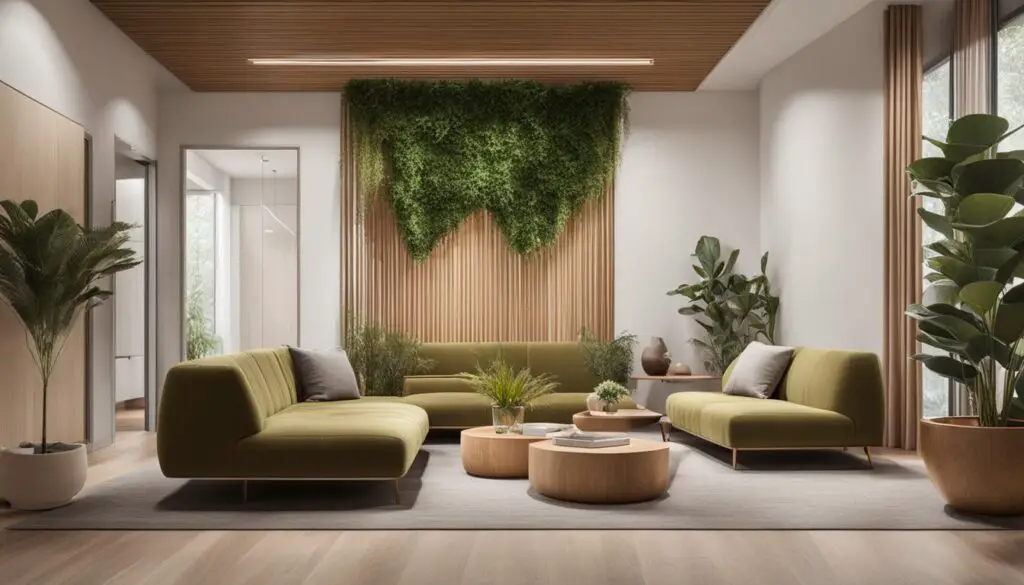
The Psychological Impact of Colors in Psychotherapy Offices
Colors play a significant role in shaping the psychological impact of psychotherapy offices. When designing these spaces, it is essential to consider color psychology and its effect on emotional well-being, calmness, trust-building, and open communication. The careful selection of colors can create an environment that promotes healing, transformation, and a sense of safety.
Research suggests that different colors elicit specific neurological responses, stimulating emotions and rational thinking. In psychotherapy offices, blues are often used to create a calm and serene ambiance. This color promotes relaxation, reduces anxiety, and helps clients feel at ease during their therapy sessions.
Earth tones such as browns and greens are another popular choice in psychotherapy offices. These colors are associated with stability, grounding, and fostering trust. Earthy hues create a warm and nurturing atmosphere, encouraging clients to feel safe and secure within the therapeutic space.
Warm and inviting colors like yellows, oranges, and light pinks can facilitate open communication. These colors evoke feelings of warmth, positivity, and optimism, promoting a sense of comfort and encouraging clients to express their thoughts and emotions openly.
| Color | Psychological Impact |
|---|---|
| Blue | Creates a calm ambiance and reduces anxiety |
| Earth Tones | Fosters trust, stability, and grounding |
| Warm Colors | Encourages open communication and a positive atmosphere |
By strategically incorporating these colors in therapy offices, clinicians can curate emotional resonances and create an environment that enhances the therapeutic experience. The use of colors is a powerful tool that can help facilitate the healing process, build trust between therapists and clients, and provide a supportive space for personal growth and transformation.
Creating an optimal color scheme in psychotherapy offices involves understanding the specific needs and goals of the therapeutic practice. Designers and therapists collaborate to select colors that align with these objectives, ensuring that each hue contributes to the overall therapeutic environment.
Through the careful use of color, psychotherapy offices can stimulate the desired emotional responses, establish a calming atmosphere, foster trust and open communication, ultimately facilitating the healing journey for clients.
The Role of Furniture Selection and Arrangement in Therapy Spaces
Furniture selection and arrangement play a crucial role in designing therapy spaces that promote comfort, functionality, and symbolic representation. When creating a therapeutic environment, it is essential to prioritize the well-being and emotional experience of clients. Comfortable and ergonomic furniture contributes to a sense of ease and relaxation, allowing individuals to fully engage in their therapeutic process.
Comfort:
The comfort of clients should be prioritized when selecting furniture for therapy spaces. Ergonomic chairs and plush seating options provide physical support and promote relaxation. By choosing furniture that embraces the principles of comfort, therapists create an inviting and safe space where clients can feel at ease to share their thoughts and emotions.
Functionality:
Furniture in therapy spaces should not only be comfortable but also serve a functional purpose. Practical considerations such as storage solutions, workspace areas, and multi-functional pieces can enhance the overall functionality of the space. By incorporating furniture that meets the specific needs of therapists and clients, a therapy room can become a versatile environment that promotes effective therapy sessions.
Symbolic Representation:
Furniture arrangement can be used to convey openness, collaboration, and support within therapy spaces. Thoughtful placement of chairs and seating arrangements can create a sense of flow and connection, facilitating communication between therapist and client. The arrangement of furniture also contributes to the symbolic representation of the therapeutic relationship, emphasizing the importance of trust, empathy, and shared understanding.
Empirical data supports the use of furniture as a powerful tool in creating a nurturing and transformative therapeutic environment. By carefully selecting furniture that prioritizes comfort, functionality, and symbolic representation, therapists can create spaces that support the therapeutic journey of their clients.
Benefits of Thoughtful Furniture Selection and Arrangement
- Promotes relaxation and comfort for clients
- Enhances the functionality of therapy spaces
- Fosters a sense of openness and collaboration
- Facilitates effective communication between therapist and client
- Conveys symbolic representation of trust and support
Design Decisions to Benefit Animals, Pet Owners, and Veterinary Staff
When it comes to designing a veterinary hospital, several factors need to be considered to ensure the well-being of animals, the experience of pet owners, and the overall satisfaction of the veterinary staff. Incorporating thoughtful design decisions can create an environment that promotes animal comfort, enhances the pet owner experience, supports the well-being of the veterinary staff, and even contributes to revenue generation.
One important design consideration is the creation of outdoor exam areas and drive-up bays. These spaces provide a stress-free environment for animals, allowing for easier and more comfortable examinations. Additionally, designated areas for different animal species can help create a calm and soothing atmosphere, reducing anxiety for both animals and their owners.
To enhance the experience of pet owners, it is crucial to have welcoming and comfortable spaces within the veterinary hospital. Soft textiles, comforting aesthetics, and cozy waiting areas can help create a sense of calm and reassurance. This not only improves the overall experience for pet owners but also contributes to a positive perception of the veterinary hospital.
The well-being of the veterinary staff should not be overlooked. Consideration should be given to personal care areas, such as break rooms or relaxation spaces, where staff members can recharge and de-stress. Ergonomic workstations that prioritize comfort and promote proper posture can also contribute to the well-being of the veterinary staff, reducing the risk of physical strain and discomfort.
Furthermore, incorporating revenue-generating spaces within the veterinary hospital can contribute to its overall success. These spaces can include retail areas for pet supplies, grooming services, or even partnerships with pet insurance providers. By offering additional services, the veterinary hospital can generate revenue while providing convenience and quality care to pet owners.
In addition to revenue generation, incorporating energy-efficient design elements can have positive impacts on both the environment and the hospital’s financial sustainability. Utilizing sustainable materials, implementing energy-efficient lighting systems, and optimizing HVAC systems can reduce energy consumption and operational costs in the long run.
Benefits of Design Decisions
By making thoughtful design decisions that prioritize animal well-being, enhance the pet owner experience, support the well-being of the veterinary staff, and promote revenue generation, veterinary hospitals can create a harmonious and successful environment for all stakeholders.
| Benefit | Description |
|---|---|
| Animal well-being | Reduced stress for animals, leading to improved health outcomes and higher client satisfaction. |
| Pet owner experience | A welcoming and comfortable environment fosters trust, improves satisfaction, and promotes positive word-of-mouth referrals. |
| Veterinary staff well-being | Personal care areas and ergonomic workstations contribute to staff morale, job satisfaction, and overall well-being. |
| Revenue generation | Additional services and revenue-generating spaces support financial sustainability and growth opportunities. |
Conclusion
The integration of acoustic design elements in biophilic architecture plays a crucial role in creating serene and nature-inspired spaces that enhance well-being. Whether it’s in therapy spaces or veterinary hospitals, these design considerations are essential for fostering relaxation, trust-building, and open communication.
By incorporating acoustic design principles, such as soundproofing walls and strategic placement of entrances and exits, therapy spaces can provide a tranquil environment where clients feel safe and supported. Veterinary hospitals can prioritize noise control measures, optimizing traffic flow for pets and minimizing distractions for both animals and staff.
Biophilic architecture not only offers aesthetic benefits but also contributes to the overall well-being of individuals. The connection with nature enhances mental health, promotes calmness, and boosts creativity. It reduces stress, improves air quality, and increases concentration, ultimately creating spaces that support the well-being of everyone involved.
Incorporating biophilic architecture, acoustic design, and thoughtful consideration into veterinary hospital design and therapy spaces is crucial. These design elements and principles help create harmonious environments that prioritize well-being and enhance the connection between individuals and nature.
FAQ
What are the benefits of acoustic design elements in biophilic architecture?
Acoustic design elements in biophilic architecture play a pivotal role in creating serene and nature-inspired spaces that enhance well-being. They provide benefits such as reduced stress, improved air quality, increased concentration, and enhanced creativity.
How do indoor plants contribute to biophilic design?
Indoor plants are an essential component of biophilic design, bringing nature into living spaces. They enhance visual appeal and act as natural air purifiers, improving indoor air quality. They also contribute to mental well-being, reducing stress, increasing concentration, and promoting creativity.
What acoustic considerations are important when designing a veterinary hospital?
When designing a veterinary hospital, acoustic considerations are crucial for creating a comforting environment for animals and humans. The floorplan should optimize traffic flow, strategically placing entrances, exits, and waiting areas. Noise control measures such as soundproof walls and sound-absorbing materials should also be implemented to create a quiet and calm environment.
How can the design of a psychotherapy office create a tranquil and healing environment?
The design of a psychotherapy office plays a crucial role in creating a tranquil and healing environment. Comfort should be prioritized with ergonomic furniture and soft textiles. Personalization through artwork and decor adds warmth. Color psychology is important, with soothing blues for relaxation and earthy tones for grounding. Furniture arrangement should facilitate flow and connection to promote open communication.
What is the impact of colors in psychotherapy offices?
Colors in psychotherapy offices have a profound psychological impact on clients. Blues create a calm ambiance, while earthy tones foster trust and stability. Warm and inviting colors encourage open communication. The selection of colors should be strategic, considering the emotional impact and therapeutic goals.
How does furniture selection and arrangement affect therapy spaces?
Furniture selection and arrangement are key aspects of therapy spaces. Comfort should be prioritized with ergonomic chairs and plush seating. Furniture should also be functional, serving its purpose while enhancing the therapeutic experience. Symbolic representation through furniture arrangement conveys openness, collaboration, and support.
How can the design of a veterinary hospital benefit animals, pet owners, and veterinary staff?
Designing a veterinary hospital involves considering the well-being of animals, the experience of pet owners, and the well-being of the veterinary staff. Designing outdoor exam areas and drive-up bays can reduce stress for animals. Welcoming and comfortable spaces benefit pet owners. The design should also prioritize the well-being of the veterinary staff, with personal care areas and ergonomic workstations.
What are the key considerations in creating spaces that foster well-being?
The integration of acoustic design elements in biophilic architecture contributes to serene and nature-inspired spaces that enhance well-being. Design considerations for therapy spaces and veterinary hospitals are crucial for creating environments that foster relaxation, trust-building, and open communication.



